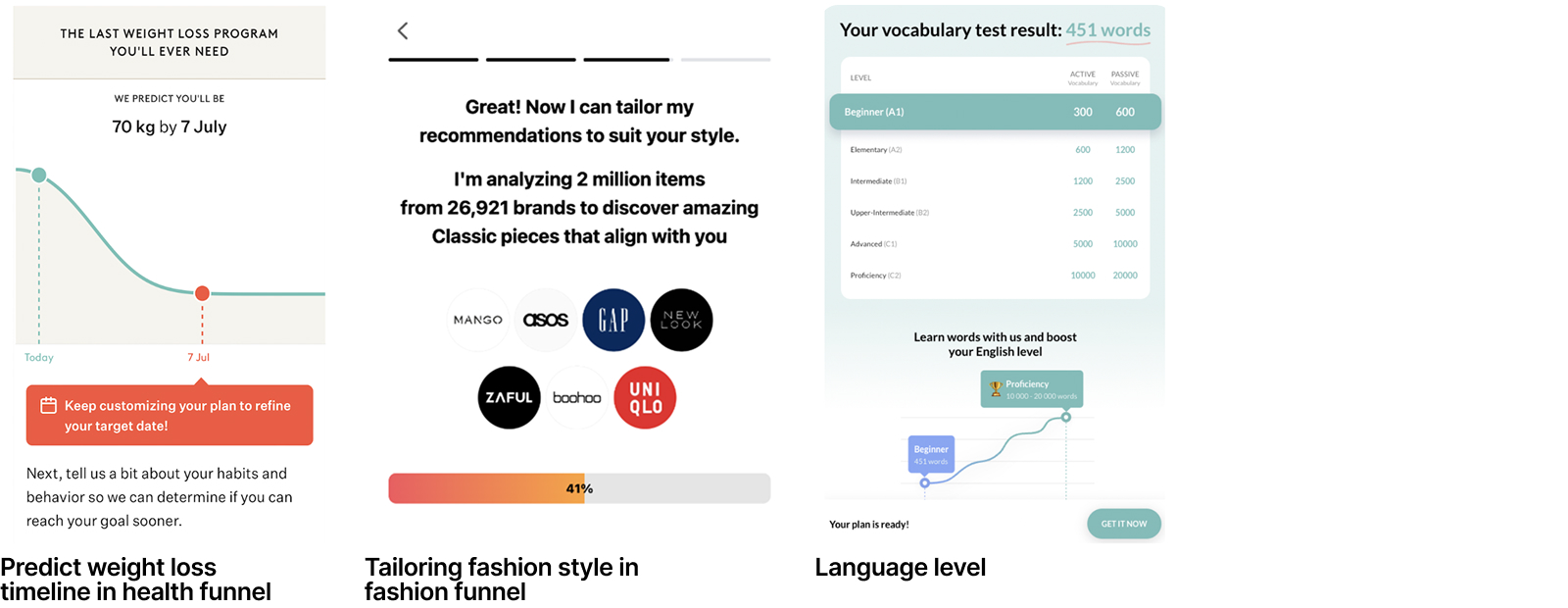We know mobile app marketing can feel overwhelming. But hey, don’t worry: this guide will walk you through everything you need to know for 2025, from planning before you launch to keeping users coming back. We’ll cover the core concepts, app marketing strategies worth your time, and the tools that help make sense of it all.
Whether you’re just getting into app marketing or looking to fine-tune an existing strategy, this is your starting point.
What is mobile app marketing?
Mobile app marketing is everything you do to get users to discover, install, start using your app, and keep coming back. Its goal isn’t to simply drive downloads but to create value that’s measurable, sustainable, and compounding over time.
Marketing an app goes far beyond app store visibility. Mobile marketing spans multiple platforms and touchpoints, meets users long before they ever visit the store, guides them to their first “aha” moment, and brings them back long after. To make that work, you need a system:
- Pre-launch: market research, messaging, landing pages, early access
- Acquisition: paid ads, ASO, influence marketing, web-to-app
- Activation: onboarding flows, first-time experience
- Retention: push, email, in-app messaging, habit loops
- Monetization: paywalls, subscriptions, offers, upsells
In many teams, this system spans both the app and the web: users discover the product, go through a web journey (landing pages, funnels, checkouts), and only then land in the store or the app. Web-to-app platforms such as FunnelFox help connect these web touchpoints with in-app experience as one marketing flow.
Each stage plays a different role in app marketing, but none of them work in isolation. Let’s break them down one by one.
💡 Want to know which metrics matter at each stage? → Click to jump to the metrics table
The 5 stages of a good app marketing strategy (and what to do at each one)
1. Pre-launch: set the foundation
If you’re starting from scratch — no existing audience, no traffic, no users — this is where you begin marketing your mobile app.
Simply put, your goal at the pre-launch stage is to build confidence that your app solves a real problem for a real audience and that you know how to talk about it. It’s also where you start building visibility and traction, long before the app shows up in the store.
Here’s what matters most at this stage.
1. Understand your user
You probably did some audience research back when you were shaping the product. Now it’s time to go deeper to understand who your users are as users, and what they’re doing instead of using your app.
Start your app marketing efforts with competitors’ research — see which apps solve the same problem, what users love, what frustrates them, and what’s missed. Then go where your audience talks: Reddit, Discord, forums, review sections. Pay attention to how they describe the problem, as their language will shape yours.
This early research directly affects your further app marketing strategy, messaging, and onboarding, so don’t skip it.
2. Articulate your messaging
A strong message is built around two things: what your app helps people do, and why that’s better than what they’re doing now.
To see what resonates, test. Run low-budget campaigns with different angles on your value prop. A/B test headlines and CTAs. A/B test headlines and CTAs, then watch which framing converts better.
3. Build a landing page
Your landing page is the backbone of your entire pre-launch strategy and of everything that follows. It’s where you test messaging, capture interest, kick off SEO efforts, and start building your audience. It also gives you early data: which message drives signups, which CTA performs better, and where users drop off. If there’s a web-to-app funnel in your app marketing roadmap, this is where it can start.
Keep it simple: clear headline, short message, focused CTA. Add a short demo or animation if you can. And yes, collect emails or other contact info. You’ll need them soon.
4. Start building a public presence
Once your messaging is dialed in and the landing page is live, it’s time to start showing up. You don’t need a full-scale launch campaign, but you do need to let people know the app is coming.
Start small: share updates on social, talk about what you’re building and why, post screenshots, work-in-progress updates, or thoughts on the problem you’re solving. Join communities where your future users already hang out and start participating early — not to market your app but to be present where your users already are.
You can also open early access to a few testers to get feedback and keep the most engaged people in the loop.
2. Acquisition: getting the right users in the door
Marketing a mobile app often starts with user acquisition — that’s where most efforts (and budgets) go. For any app marketing plan to succeed, the goal at this stage is to attract the right users — the ones who are most likely to activate, stick around, and convert. There are two main ways to bring users in: paid and organic acquisition.
Organic acquisition
Organic UA is how people find your app without ads — through search, content, social, or word of mouth. It takes time, but compounds over the long run and costs less to maintain.
Here’s where to start:
- App Store Optimization (ASO). Use high-intent keywords in your title and description, optimize visuals (icon, screenshots, video), localize for key markets, and collect ratings and reviews.
- SEO & content marketing. Build landing pages and blog posts around what your users search for.
- Social & communities. Pick the platforms your audience uses, post there consistently, and engage in comments.
- Referrals & cross-promo. Add referral rewards to your app and look for partnerships with non-competing apps that serve the same audience.
Paid acquisition
Organic growth plays a long game. Paid acquisition gets you there faster, and for many teams, it’s a core part of their mobile app marketing strategy. But in 2025, it’s trickier to get right due to rising ad costs and limited tracking.
There are two ways to run paid UA:
- Direct-to-app. A user clicks an ad and goes straight to the App Store or Google Play. It’s simple, but you don’t control what happens after the click.
- Web-to-app. Instead of sending users to the store right away, you first bring them to a landing page, guide them through onboarding and purchase on the web, and then send them to the app. It takes a bit more setup but gives you better data, more control, and often better results.

Web-to-app flows can be built either in-house with custom development or with dedicated funnel and billing platforms that remove the need for manual coding. With platforms like FunnelFox, teams can assemble a full web-to-app funnel in a matter of hours and iterate on it without engineer involvement.
New to the web-to-app strategy? Download our web-to-app funnel guide to learn how to build, launch, and scale high-converting funnels in a few hours.
Once you’ve picked your approach (actually, you can use both simultaneously), it’s time to choose where to run your campaigns. In mobile app marketing, channel affects everything — from how much you pay, to how well you can optimize — and each channel comes with its own trade-offs: cost, targeting, and creative demands.
How the top paid UA channels stack up
| Channel | Available for | Placement | Targeting | Creative control | Strengths | Weaknesses |
| Apple Search Ads (ASA) | Direct-to-app | App Store search | Keywords | Low in Basic High in Advanced | High-intent traffic Precise targeting App Store native | iOS-only Expensive Limited reach outside store |
| Google App Campaigns (UAC) | Direct-to-app | Google Play Search YouTube Display Discover | Automated (based on assets and user data) | Limited | Massive reach Low setup effort | Low transparency Hard to optimize manually |
| Meta | Both | Feeds Stories Reels | Advantage+ AI targeting Custom /lookalike audiences | High | Mature platform Good ROAS at scale Strong remarketing | High CPIs Performance drops without good creative |
| TikTok | Both | For You feed | Broad + interest-based, improving algorithm | High | High engagement Great for UGC-style ads | Creative fatigue Short ad lifespan |
| Snapchat | Direct-to-app | Stories Discover | Demographic Interest-based | Medium | Young audience Native formats | High cost Narrow appeal |
| Reddit Ads | Web2app | Community feeds Banners | Subreddit-based, interest | High | Niche targeting High intent | Strict community rules Lower scale |
| Spotify Ads | Web2app | Audio Video interstitials | Demographic Interest Behavior | Medium | Immersive, unique format | Demographics Interest Behavior |
| In-app ad networks | Web2app | Other apps (rewarded, interstitials, playables) | Contextual or behavior-based | Medium | Engaged users Great for games | Limited LTV visibility Lower retention |
| Affiliate & referral | Web2app | Influencer blogs Media Social | Depends on partner | Low–medium | Performance-based Scalable | Needs tracking setup & quality control |
| Content ads (Taboola, Outbrain) | Web2app | News sites Blogs Content feeds | Contextual | High | Low-cost traffic Native appearance | Low intent Needs funnel to convert |
| CPA & affiliate networks | Web2app | Third-party publisher channels | By publisher | Low | Pay-per-result Flexible scale | Hard to manage quality Requires vetting |
3. Activation: get users to value fast
Activation is the point in your app marketing funnel when users feel the value of your app for the first time. If it doesn’t happen quickly, most users won’t come back. You don’t have to show them everything right away, just quickly get them to one small win.
Find your “aha” moment
What’s the first action that shows a user understands the value of your app? For a fitness app, it might be completing a workout. For a notes app, saving their first note. Pick that one action and find a way to get users there with minimal friction.
Make onboarding feel easy
Long tutorials, forced signups, and too many steps can overwhelm new users. A smooth onboarding flow is a crucial part of successful mobile app marketing, so keep it simple: reduce friction, hold off on logins or paywalls until after they’ve seen some value, and let users try one small thing without making them commit right away.
Personalize early flows
Use what you know about the user — where they came from, what ad they clicked, their region or device — to make onboarding feel more relevant. Even small tweaks can improve the experience and support better app marketing results later.
Remove blockers before they happen
Watch what new users do in their first session. Where do they pause, skip steps, or drop off? Tools like session recordings, simple analytics, or quick surveys can help you identify friction and smooth it out.
Show progress and feedback
A little encouragement never hurts. When users feel like they’re making progress — even in small ways — they’re more likely to keep going. Try subtle touches: a progress bar, a quick “Nice!” message. It makes the app more rewarding to use.
4. Retention: keeping users coming back
Most apps see a big drop-off in the first few days, so you need a clear plan for keeping users engaged. It’s not just a push notification play: retention is both a product challenge and a marketing one and directly affects how much users spend, how long they stay, and whether your acquisition & app marketing efforts pay off.
Here’s what helps:
Understand where users drop off
Your retention curve will tell you a lot. If people leave on Day 1, look at onboarding or expectations. If they churn on Day 7 or 30, the problem is probably content, engagement, or pricing.
Focus on the right users
Not everyone needs to be saved. Prioritize users who’ve shown signs of interest — e.g., finished onboarding, used key features, or subscribed once. That’s where your app marketing efforts will pay off the most.
Trigger engagement with intent
Push, email, and in-app messages work only when they’re tied to the right moment. Set up simple, behavior-based triggers: unfinished tasks, long gaps in activity, or missed streaks. Remind users what they started, what they’ll gain, or what they might miss. The more relevant the message feels, the more likely they’ll come back.
Reinforce the habit
The first few days matter most. Help users build momentum with streaks, reminders, or small wins tied to actual value, but don’t overdo gamification just for the sake of it.
Keep things fresh
Regularly release new content, features, or limited-time offers to show your app is worth checking in on again.
Test and iterate
In user experience, small changes can make a big difference. A/B test your flows, paywalls, timing, and messages. Sometimes shifting a push by 30 minutes or tweaking a headline can lift retention.
5. Monetization: turn engagement into revenue
The best time to monetize is right after the user sees real value. Here’s how to align your offers with that moment and make them feel like a natural next step.
Start with value, not pricing
Before you ask someone to pay, make sure they’ve seen what your app can do — if there’s no value yet, no discount will change their mind. Let them try a few key features or see a preview of what’s behind the paywall.
💡 Web-to-app funnels let users feel your app’s value even before they install it, so give them a sneak peek during the quiz onboarding.

Choose the right model for your app
Subscriptions, one-time purchases, consumables, freemium — each model has trade-offs. Think about how often people use your app, how much value they get, and what feels natural. For many mobile marketing app teams, hybrid models (like free trials + paid plans + upsells) tend to work best.
Test and optimize your paywall
Try different prices, copy, button placements, and timing. Small tweaks can make a big difference. One version won’t work for everyone, so test by audience, channel, or lifecycle stage.
💡 The most effective paywalls usually have three-option pricing tiers: 1-4-12 weeks or 1-3-12 months. Pre-selecting a middle-tier option can help reduce decision fatigue and guide users to the right choice.
Consider monetizing on the web
App stores take up to 30% in fees and hold payouts for weeks. Taking your monetization to the web boosts revenue and gives you more control over the user journey and data.
Web monetization is typically handled through external billing platforms that work outside app store restrictions and connect web checkouts with the app. One example of such a platform is FunnelFox, which is used to run web payments and sync paid users back into the app.
How to measure your app marketing strategy performance: metrics, attribution, tools
Let’s find out which metrics matter, why attribution as we knew it is basically dead, and how to build a useful, lean analytics stack without breaking the bank.
Here’s what to watch and what “good” looks like
| Stage | Metric | Why it matters | Benchmark (avg) |
| Pre-launch | Landing page CTR | Shows how well your value prop grabs attention | 2–3% CTR |
| Pre-launch | Signup or waitlist rate | Measures early user interest and intent | 20–30% conversion to signup/waitlist |
| Pre-launch | Email open rate | Tells you if users are engaging with your updates | 20–30% open rate |
| Acquisition | CPI (Cost per Install) | Good benchmark, but needs retention context | $1–2 (can go up to $5+ in competitive niches) |
| Acquisition | CAC (Customer Acquisition Cost) | Tells if your growth is financially sustainable | Varies considerably |
| Acquisition | ROAS (Return on Ad Spend) | Measures campaign profitability | Aim for 100%+ ROAS within 30 days |
| Acquisition | Click-to-install (CTI) | Shows where friction might be in your funnel | 50–70% is solid; <40% may signal friction |
| Activation | Activation rate | Tracks how many users reach the first value moment | Varies considerably |
| Activation | Time-to-value | Shows how quickly users get value | Within first session is ideal |
| Retention | Day 1 / 7 / 30 retention | Highlights onboarding or product issues over time | Day 1: 25–30%, Day 7: 10–15%, Day 30: 5–7% |
| Retention | Churn rate | Helps find out when and why users leave | Target <4-10% monthly |
| Retention | Session frequency | Indicates stickiness and ongoing engagement | 3–5 sessions/week is healthy |
| Monetization | ARPU (Average Revenue per User) | Helps compare revenue across channels or cohorts | No standardized benchmark |
| Monetization | LTV (Lifetime Value) | Core of your payback model | 3× CAC is a good benchmark |
| Monetization | Conversion to paid | Reveals how well your monetization funnel works | Aim for >2% |
| Monetization | Refund & cancel rate | Flags weak value delivery, poor onboarding, missing features, and other problems | Aim for <6-7% |
These are average numbers gathered from various sources. Depending on your vertical and other factors, benchmarks may vary.
How attribution changed, and what to do now
A few years ago, you could track exactly which ad brought in which user. Now, privacy updates (like Apple’s ATT and Google’s Privacy Sandbox) limit how much user-level data you can collect. That doesn’t mean you can’t measure impact — it just means app marketing teams have to shift from user-level precision to pattern-based insight.
Here’s what to focus on instead:
- Look at the bigger picture. Don’t chase exact sources, but focus on patterns: how a channel performs over time, what happens after the installation, and how users behave.
- Watch in-app behavior. Track users’ activation, retention, and monetization. That tells you more than raw install numbers.
- Use web-to-app funnels for better attribution. If you’re using web-to-app funnels, you can track more before users hit the store.
This kind of pre-store attribution is usually implemented at the web funnel and billing layer. Platforms like FunnelFox are used to connect ad traffic, on-page behavior, checkout events, and app installs into one measurable acquisition path.
Your analytics stack
You don’t need a big budget to set up a solid app marketing analytics stack. Here’s a basic bundle that works for most apps:
- Product analytics: Mixpanel, Amplitude, or Firebase. See what users do in the app and where they drop off.
- Attribution: AppsFlyer (paid), Firebase (free), or Adjust. Understand where users come from and how valuable they are.
- Web analytics: GA4, Plausible, or similar. Track traffic, clicks, and conversions before users reach the store.
💡 Start simple. The goal isn’t to track everything — it’s to track the right things and use them to make better decisions.
What to keep in mind when building your app marketing strategy for 2025
1. App Store Optimization
ASO should be part of your mobile app marketing plan as it still drives a huge share of installs — especially on iOS, where over 60% of downloads start with search. But what worked five years ago doesn’t cut it anymore. In 2025, you need to optimize for conversion, not just visibility: custom product pages, localized creatives, and A/B testing screenshots and messaging.
2. Adapting to SKAN and Privacy Sandbox
You won’t get perfect attribution anymore. Focus on aggregated performance: channel-level ROAS, cohort LTV (lifetime value), blended CAC. SKAN 4 and Google’s Sandbox require new tooling, but also open the door for smarter, more privacy-compliant app marketing.
3. TikTok & UGC
TikTok is now a top-tier UA channel. Native-looking creative, influencer collaborations, and trend-based content are your go-to formats if you’re marketing your app on this platform.
↘ Learn how to make the most out of your TikTok campaigns with TikTok Pixel
4. Onboarding with micro-interactions & gamification
Onboarding doesn’t need a full tutorial. Instead, use small nudges, guided tooltips, rewards, or progress bars to make first-time use feel clear and satisfying. Goal: get to the “aha” moment fast.
5. Smarter subscriptions, upsells & win-backs
A well-thought-out monetization strategy is a key part of effective mobile app marketing. Test free trials, lifetime plans, and time-limited discounts. Add upgrade offers after the value is shown, not before. Use win-back flows for users who churn early, and exit surveys to learn why.
💡 Pro tip: In web-to-app funnels, you can implement custom, personalized cancellation flows and run effective win-back campaigns.
6. Monetizing outside the store
Web paywalls = lower fees, faster payouts, and better control. If your app supports it, add checkout on the web before sending users to the app. This also helps you bypass app stores limits (like Apple’s 30% cut and delayed payouts).
💡 On the web, you can enable custom checkouts which perform 20-30% better than default ones.
7. Retargeting in a post-cookie world
What is the digital marketing strategy that tracks users across the web? Retargeting — though in 2025, it only works if you do it right. Use server-side tracking (Meta CAPI, GA4, Adjust S2S) and focus on broad audiences, owned data (email/push), and contextual re-engagement—especially for web visitors and lapsed subscribers.
8. Web-to-app funnels
In 2025, app marketing continues to shift to the web, where you have more control over data, conversion, and revenue.
Instead of sending users straight to the App Store, you guide them through a web journey first:
ad → landing page → onboarding → web checkout → app install
It takes a bit more setup, but the upside is huge:
- Better attribution. No more SKAN delays or ATT blind spots. You get full-funnel tracking — from first click to final purchase — and granular data by campaign, creative, or user segment.
- Lower fees, higher revenue. App Store takes up to 30%, and web payments just 2–5%. That’s revenue you can reinvest. Plus, you control pricing, trials, upsells, payment methods, and even win-back flows post-cancellation.
- Access to new UA channels. Google Search Ads, Taboola, Outbrain, and affiliate traffic — all hard or impossible with app-first flows. Web-to-app unlocks them with proper UTMs and session-level tracking.
- Faster payouts. Don’t wait 30–60 days for Apple to send your money. With web monetization, payouts land in days (or hours), so you can reinvest faster.
- Real-time A/B testing. Test landing pages, onboarding, paywalls, and offers without app review delays. Ship fast, learn faster.
- Personalization. Create dynamic onboarding flows, personalized paywalls, and custom offers based on user behavior, all without store restrictions.
FunnelFox can become the perfect addition to your mobile app marketing strategy. Build and launch web-to-app funnels in just a few hours, choose and switch payment providers, test every element for better conversion, create custom paywalls and checkouts to boost conversion, control churn with custom cancellation flows, and increase revenue with one-click upsells and upgrades. No technical skills required.
That’s a wrap
In a nutshell, mobile app marketing is about building a system that works — one that connects with the right users, delivers value fast, and keeps them coming back.
We hope this guide gave you a clear picture of mobile app marketing in 2025. Whether you’re building your first strategy or fine-tuning your 50th campaign, keep testing, keep learning, and keep the user at the center. Good luck out there! You’ve got this.









